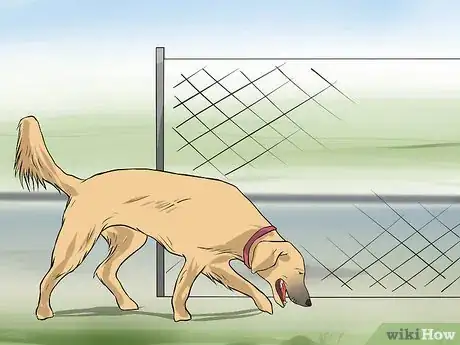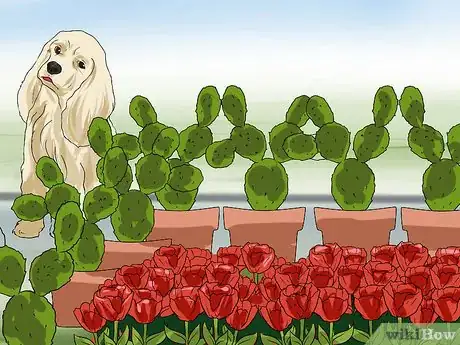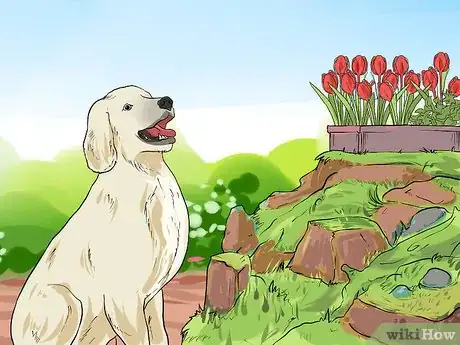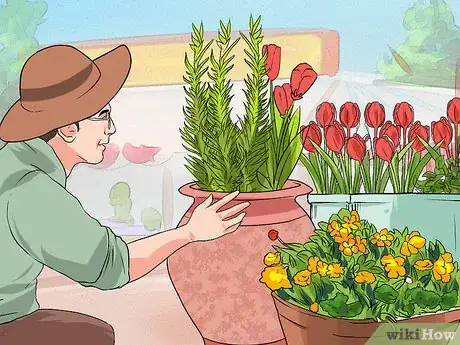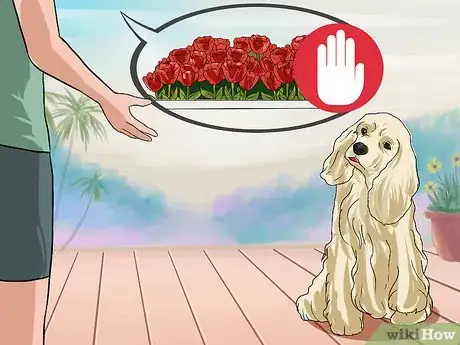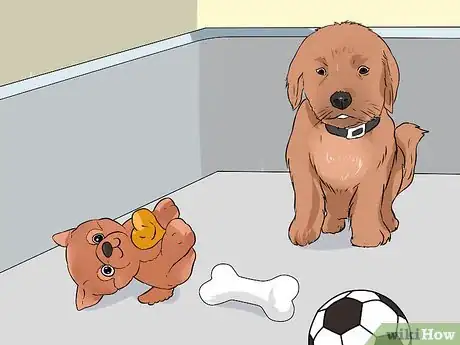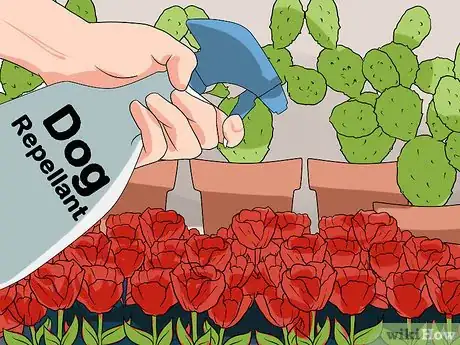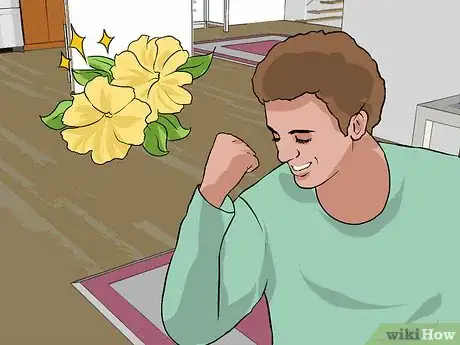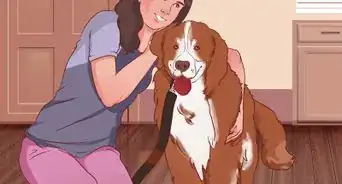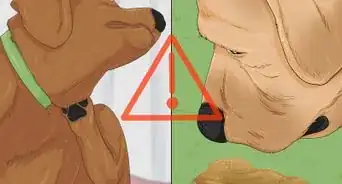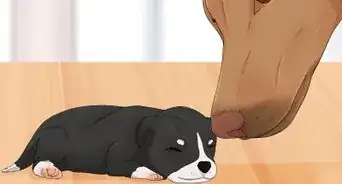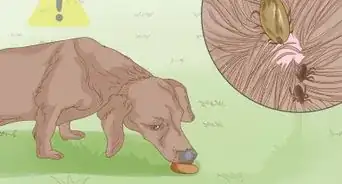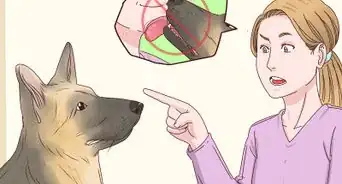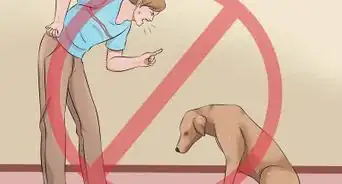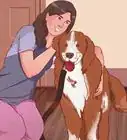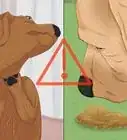This article was co-authored by Alexis Toriello. Alexis Toriello is a Certified Dog Behavior Consultant and the Founder and CEO of Zen Dog Training in New York. Her time working as a canine behavior specialist in various animal shelters has made her knowledgeable in assessing, rehabilitating, and training dogs. In addition to being an Associate Certified Dog Behavior Consultant (ACDBC), Alexis is a Certified Professional Dog Trainer - Knowledge Assessed (CPDT-KA) and a Master’s Degree Candidate in Animal Behavior and Conservation at Hunter College. She is certified by the American Red Cross in Canine First-Aid and CPR and has endorsements from numerous hospitals and clinics and the Washington Humane Society.
This article has been viewed 86,049 times.
Are dogs getting in your flower beds? While dogs can be loyal and fun companions, they can really make a mess of your prized petunias. To keep your pup, or neighborhood pups, out of your beautiful flower beds, you will either need to change their behavior or change your beds a bit.
Steps
Preventing Dogs From Getting in Your Flower Beds
-
1Fence in your flower beds. This should send a message to your dog, or other dogs in the area, that he or she is not allowed in your garden.[1] Ensure that the fence is sturdy and tall enough so a dog can't simply push it over or jump over it.
- Many times dogs simply wander into flower beds because they are just areas that are easily accessible. Simply making access more difficult with a short fence will deter many dogs from entering.
-
2Consider growing barrier plants.[2] Tall, thorny, or especially fragrant plants can be a great deterrent for dogs. Planting a row of thorny roses or other prickly plants along the edge of your flower bed will make the area much more unappealing to a dog looking for a place to dig or lounge around.Advertisement
-
3Make your flower beds unappealing by adding tastes and smells that dogs don't like.[3] Dust the edges of your flower beds with red pepper powder or other pungent spices. You could also sprinkle strong smelling liquids, such as vinegar, around the edges of your beds.
- Make sure that whatever you use as a deterrent is unpleasant for a dog but it not toxic to it. The goal should be to deter dogs from entering your beds, not to injure them.
- Don't use commercial repellents made to repel deer or rabbits.[4] Most of these products contain coyote urine, which keeps deer and rabbits at bay but attracts the interest of dogs.
-
4Locate flower beds in inaccessible areas. Place your prized flowers that are not in the path of neighborhood animals. Backyards or side yards are less likely to have unwanted visitors than the front of a yard near a sidewalk or street. You shouldn't have to limit what and where you plant necessarily, but use common sense when choosing the right spot for a delicate and special flower specimen.
-
5Switch to container gardening if your flowers are getting repeatedly trampled.[5] Dogs are less likely to get into pots or raised beds, as access it inherently more limited than flat areas of a yard. Having raised beds will not guarantee that your pooch won't go tromping through it but it will make the occurrence less likely.
Training Your Dog to Stay Out of Flower Beds
-
1Start training your dog at a young age. Puppies are ripe for training and most thrive under a kind and productive training system. Even puppies that are less than a few months old can learn commands successfully.[6]
-
2Let your dog know that the flower beds are off limits as soon as you can. It is easier to let a dog know it can't go somewhere before it ever does, versus teaching it after it has enjoyed the area already.
- While training your dog to stay in designated areas, it's a good idea not to leave it alone with the temptation and ability to break the rules. This is basically just setting your pooch up for failure.
-
3Have a designated area where your dog can play and roam. Make sure the area is inviting and fun for the dog. Have some toys and enough space to play, so that the pup doesn't need to look for other areas to explore.[7]
- You can also designate an area where your dog can dig, if that is what they are doing in your flower beds. Make your dog's digging area appealing to them. Encourage them to play there, letting them tear up the area as much as they like.
- Prevent your dog from digging in the soil by placing chicken wire, large rocks, or a plastic membrane over the earth.
-
4Don't scold your dog when he or she tries to enter the flower beds. Scolding the dog could teach them to go into the flower bed for attention. The owner needs to be more subtle, such as distracting the dog and then rewarding the dog for the good behavior.
-
5Try a commercial dog repellant. When the dog isn't there, you can either spray it around the bed. Don't spray directly at the dog. It may not be clear to the dog why it is being sprayed and what behavior you would like it to stop in response to the spraying. Spraying repellant when the dog is there is going to teach the dog to avoid you, rather than the flower bed.
-
6Be consistent. You need to be consistent with your disapproval, never letting the dog wander into the flower beds without facing negative consequences. Also be consistent with your praise when a dog follows your command. Give it positive reinforcement with treats if need be. This will give your dog a good reason to do as you ask.
-
7Hang in there! Keeping your dogs out of your flower beds will require persistence. No dog will get the message that you don't want him or her in your flowers right away. Just try to make it as clear and consistent as possible. Above all, keep playing with your dogs and let them know you love them, even if they do dig up your prized petunias once in a while.
Expert Q&A
-
QuestionHow do I dog-proof my garden?
 Alexis TorielloAlexis Toriello is a Certified Dog Behavior Consultant and the Founder and CEO of Zen Dog Training in New York. Her time working as a canine behavior specialist in various animal shelters has made her knowledgeable in assessing, rehabilitating, and training dogs. In addition to being an Associate Certified Dog Behavior Consultant (ACDBC), Alexis is a Certified Professional Dog Trainer - Knowledge Assessed (CPDT-KA) and a Master’s Degree Candidate in Animal Behavior and Conservation at Hunter College. She is certified by the American Red Cross in Canine First-Aid and CPR and has endorsements from numerous hospitals and clinics and the Washington Humane Society.
Alexis TorielloAlexis Toriello is a Certified Dog Behavior Consultant and the Founder and CEO of Zen Dog Training in New York. Her time working as a canine behavior specialist in various animal shelters has made her knowledgeable in assessing, rehabilitating, and training dogs. In addition to being an Associate Certified Dog Behavior Consultant (ACDBC), Alexis is a Certified Professional Dog Trainer - Knowledge Assessed (CPDT-KA) and a Master’s Degree Candidate in Animal Behavior and Conservation at Hunter College. She is certified by the American Red Cross in Canine First-Aid and CPR and has endorsements from numerous hospitals and clinics and the Washington Humane Society.
Certified Dog Behavior Consultant It can help to put up a fence or barrier if your dog constantly gets into your garden.
It can help to put up a fence or barrier if your dog constantly gets into your garden. -
QuestionHow do I stop my dog from eating my garden?
 Alexis TorielloAlexis Toriello is a Certified Dog Behavior Consultant and the Founder and CEO of Zen Dog Training in New York. Her time working as a canine behavior specialist in various animal shelters has made her knowledgeable in assessing, rehabilitating, and training dogs. In addition to being an Associate Certified Dog Behavior Consultant (ACDBC), Alexis is a Certified Professional Dog Trainer - Knowledge Assessed (CPDT-KA) and a Master’s Degree Candidate in Animal Behavior and Conservation at Hunter College. She is certified by the American Red Cross in Canine First-Aid and CPR and has endorsements from numerous hospitals and clinics and the Washington Humane Society.
Alexis TorielloAlexis Toriello is a Certified Dog Behavior Consultant and the Founder and CEO of Zen Dog Training in New York. Her time working as a canine behavior specialist in various animal shelters has made her knowledgeable in assessing, rehabilitating, and training dogs. In addition to being an Associate Certified Dog Behavior Consultant (ACDBC), Alexis is a Certified Professional Dog Trainer - Knowledge Assessed (CPDT-KA) and a Master’s Degree Candidate in Animal Behavior and Conservation at Hunter College. She is certified by the American Red Cross in Canine First-Aid and CPR and has endorsements from numerous hospitals and clinics and the Washington Humane Society.
Certified Dog Behavior Consultant Distract your dog by playing with other toys so they aren't as tempted to go into your garden.
Distract your dog by playing with other toys so they aren't as tempted to go into your garden. -
QuestionSurely not scolding lets a dog get away with things you don't want them to?
 Pippa Elliott, MRCVSDr. Elliott, BVMS, MRCVS is a veterinarian with over 30 years of experience in veterinary surgery and companion animal practice. She graduated from the University of Glasgow in 1987 with a degree in veterinary medicine and surgery. She has worked at the same animal clinic in her hometown for over 20 years.
Pippa Elliott, MRCVSDr. Elliott, BVMS, MRCVS is a veterinarian with over 30 years of experience in veterinary surgery and companion animal practice. She graduated from the University of Glasgow in 1987 with a degree in veterinary medicine and surgery. She has worked at the same animal clinic in her hometown for over 20 years.
Veterinarian Scolding is a more complex topic than 'do' or 'don't'. Modern dog training tunes in to dog psychology and their motivation. We know attention — any attention — is a potent reward for dogs. When an action is repeated, the dog is more likely to repeat it, hence the advice not to scold. The other point is scolding is a flawed deterrent. Say you hit your dog when it dug in the flower bed. The dog associates the punishment with your presence, so stays away when you're around but goes in freely when you're not there. At the very least, you need to use remote punishment so the dog regards it as an "Act of God" that is linked to the location and not a person.
Scolding is a more complex topic than 'do' or 'don't'. Modern dog training tunes in to dog psychology and their motivation. We know attention — any attention — is a potent reward for dogs. When an action is repeated, the dog is more likely to repeat it, hence the advice not to scold. The other point is scolding is a flawed deterrent. Say you hit your dog when it dug in the flower bed. The dog associates the punishment with your presence, so stays away when you're around but goes in freely when you're not there. At the very least, you need to use remote punishment so the dog regards it as an "Act of God" that is linked to the location and not a person.
References
- ↑ Alexis Toriello. Certified Dog Behavior Consultant. Expert Interview. 23 February 2021
- ↑ http://www.bhg.com/gardening/landscaping-projects/landscape-basics/gardening-with-dogs/#page=14
- ↑ http://www.houselogic.com/home-advice/gardens/how-to-keep-dogs-out-of-garden/
- ↑ http://www.houselogic.com/home-advice/gardens/how-to-keep-dogs-out-of-garden/
- ↑ http://www.bhg.com/gardening/landscaping-projects/landscape-basics/gardening-with-dogs/#page=15
- ↑ http://www.bhg.com/gardening/landscaping-projects/landscape-basics/gardening-with-dogs/
- ↑ Alexis Toriello. Certified Dog Behavior Consultant. Expert Interview. 23 February 2021
About This Article
To keep dogs out of your flower beds, try sprinkling red pepper flakes or vinegar around the edges of them, which will make them smell unpleasant to dogs. Or, you can plant tall or thorny plants around your flower beds, like rose bushes, so dogs can't get into them. Alternatively, as a last resort, you can fence in your flower beds to keep dogs out. For more tips from our Veterinary co-author, like how to train your dog not to go in your flower beds, scroll down!
